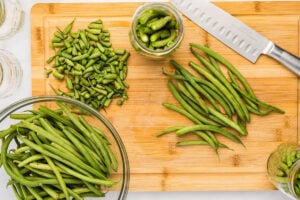How To Pressure Can Green Beans: A Practical Step By Step Guide
Learn how to can green beans with my straightforward recipe. It’s a great way to keep them fresh all year round.
This is a plain and simple tutorial, perfect if you’re new to pressure canning recipes.
Pressure Canned Green Beans Recipe
Print Recipe
Equipment
- 5 pint-sized canning jars, lids, and bands
- Jar lifter
- Canning funnel
- clean cloths
- Bubble freer or non-metallic spatula
Ingredients
- 5 pounds green beans
- 2 ½ teaspoons salt optional, 1/2 teaspoon per pint jar
- water
Save This Recipe
You'll join my email list which you will love. And if you don't, unsubscribe in one click. ❤️
Instructions
- Prepare Your Beans: Rinse the green beans thoroughly in cold water. Trim the ends, and if desired, cut or snap the beans into pieces to fit your jars.

- Clean Your Jars: Wash and heat your canning jars, lids, and bands by boiling them for 10 minutes or using a dishwasher on the sanitize cycle. Keep jars hot until ready to use.
- Pack the Beans: Tightly pack the green beans into the hot jars, leaving a 1-inch headspace at the top. If using, add 1/2 teaspoon of salt to each pint jar.

- Add Boiling Water: Pour boiling water over the beans in the jars, maintaining the 1-inch headspace. Use a bubble freer or a non-metallic spatula to remove air bubbles by gently sliding it between the beans and the jar.

- Wipe and Seal the Jars: Wipe the rims of the jars with a clean, damp cloth. Place the lids on the jars, then screw on the bands until fingertip tight.

- Process in Pressure Canner: Place the jars in your pressure canner, following the manufacturer's instructions. Process pint jars at 10 pounds of pressure for 20 minutes (adjust for altitude if necessary).

- Cool and Store: Turn off the heat and allow the canner to depressurize naturally. Carefully remove the jars using a jar lifter and let them cool on a towel or rack for 12-24 hours. Check the seals, then label and store the jars in a cool, dark place.

Notes
The use of salt is optional and for flavoring purposes only. It does not affect the safety of the canned product.
Nutrition
There’s something about the crunch and freshness of green beans that just speaks to me, especially when they’re preserved just right. My kitchen has seen its fair share of canning experiments—some hits, some misses. But, this pressure canned green beans recipe? A game-changer. It’s like bottling up a piece of summer you can enjoy any time.
A Newsletter you’ll love
Daily recipes from the farmhouse, Sunday meal plans, seasonal ideas, straight from my kitchen to your inbox.
I promise to keep your email address safe. Unsubscribe at any time

Key Ingredients and Tools
- Fresh Green Beans. You’ll find these in the produce section, often in bulk or pre-packaged bags. Fresh, crisp beans are crucial for a satisfying texture after canning.
- Canning Salt. Located in the baking aisle or near pickling supplies, canning or pickling salt is recommended to avoid cloudiness in the jars. It’s fine-grained and doesn’t contain anti-caking agents or iodine, which can affect the canned goods’ appearance.
- Water. While not unusual, the quality of water used can affect the flavor of your canned beans. If your tap water is heavily chlorinated or has a distinct taste, consider using filtered water for a cleaner taste.

- Pressure Canner. A must-have for processing the jars to ensure all bacteria are killed, making your canned green beans safe for long-term storage.
- Canning Jars, Lids, and Bands. Pint-sized jars are ideal for portion control, and using new, undamaged lids each time ensures a proper seal.
- Jar Lifter. This tool is essential for safely removing hot jars from the canner, preventing burns and accidents.
- Canning Funnel. It helps in transferring beans into jars without mess, ensuring a clean rim for sealing.
- Bubble Freer or Non-metallic Spatula. This is used to remove air bubbles before sealing the jars, crucial for preventing jar breakage and ensuring proper vacuum sealing.
Troubleshooting and Help
Sure, you can use frozen green beans if fresh ones aren’t available. Just skip the initial rinse and trim process. Keep in mind, the texture might be slightly different, but they’ll still taste great.
For green beans, you’ll need a pressure canner. Green beans are low in acid, so the high temperatures from pressure canning are necessary to safely preserve them. A water bath canner won’t reach high enough temperatures to ensure safety.
When stored in a cool, dark place, your canned green beans can last up to a year or even longer. After a year, the quality might decline a bit, but they’ll still be safe to eat if the seal is intact.
If a jar doesn’t seal after cooling, don’t worry! Just refrigerate it and use the green beans within a week or two. You can also reprocess the beans with a new lid within 24 hours, but be sure to check for any issues with the jar rim or lid that might have caused the sealing failure.
Follow these easy steps and my tips, and you’re all set to savor the fresh taste of green beans year-round.

Love,
















Is the nutritional information for a whole pint jar? serving size is not listed~ We will be trying this canning recipe this summer!
yes it’s per jar! it calculates weird and just divides by the number of servings and i though number of pints mde more sense 🙂